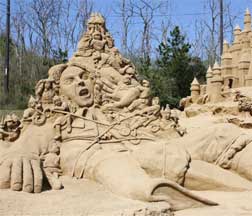|
| |
Sand castle or sand
sculpture
Main
Article page |
Beauty articles
|
Health page |
Computers|
Diseases |
Education |
Entertainment |
Family
Business |Fitness|
Fruits and Vegetables
|
Jobs |
General |
Personality|
Technology
|
Tourism |
Sports
Biography Page|
Heroes & Incredible peoples
|
Inventions
|
Useful Tips
| Stories
Arts
|
Butter sculpture |
Sand sculpture |
Vegetable carving |
Shadow arts

Shovels and buckets are the main construction tool used in creating sand
castles and sand sculptures, although some people use only their hands.
Water from the sea to mix with the sand can be brought to the building
site with a bucket or other container. Sometimes other materials, such
as pieces of wood, are added to reinforce structures.
Read more:
http://www.answers.com/topic/sandcastle#ixzz1CmJVTdHk
Sand castle or sand sculpture are
made of sand and water. Shovels and buckets are the main construction tool used
in creating sand castles and sand sculptures, although some people use only
their hands. Water from the sea to mix with the sand can be brought to the
building site with a bucket or other container. Sometimes other materials, such
as pieces of wood, are added to reinforce structures.
Sand sculpting as an art form has
become very popular in recent years especially in coastal beach areas. Hundreds
of annual competitions are held all over the world. Techniques can be quite
sophisticated, and record-breaking achievements have been noted in the Guinness
World Records.
Since 1989, a World Championship in
Sand Sculpture has been held in Harrison Hot Springs (Canada, BC), also known as
"Harrisand". The competition has solo, double and team categories. The world's
tallest sandcastle was built on Myrtle Beach in South Carolina as part of the
2007 Sun Fun Festival. The structure was 49.55 feet (15.1 m) high. It took 10
days to construct, and used 300 truckloads of sand.
On September 1, 2007, Ed Jarrett completed his world-record 31.7-foot (9.66 m)
high sand castle, at the Point Sebago Resort in Casco, Maine. The "Castle to the
Sun" was constructed to raise funds to benefit sick children at Camp Sunshine on
Sebago Lake. He created a 29-foot 3 inch (8.9 m) sand castle in Falmouth, Maine
in 2003 declared the world's tallest.
The artists use the best sand possible. A fine grain, non-eroded sand with lots
of tiny flat edges to hold all that water. Between each grain of sand there is a
tiny water bridge holding them together. The sand is compressed together in
wooden forms to remove most of the air. The less air, the stronger the bond.
In competitions, each sculptor or group of sculptors has a total of 25
hours to completely carve all the sand in their plot.
They spray a stuff on the sculptures. They use the term windscreen because that
is what it is intended to do. It forms a protective barrier on the outside of
the sculpture that prevents the wind and sun from blowing away the detail. It is
made from 1 part biodegradable glue and 10 parts plain water. They do not mix it
with the sand. It is not intended to hold the sculpture together, only to
prevent erosion
There are many factors that determine the life span of one of these
amazing ephemeral creations. Construction, compaction and the overall design
will play as large a part, as will Mother Nature herself. A well thought out
design with excellent compaction and construction can last for months even in
the harshest of weather conditions. On the other hand a poorly designed or
compacted structure or one that has stretched the limits of the sand itself may
not survive for more than a few minutes or hours.
( Source: Wikkipedia and
http://www.worldchampionshipofsandsculpting.com )
More..
| |
|



